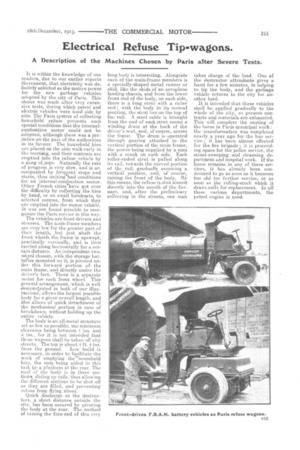Electrical Refuse Tip-wagons.
Page 7

If you've noticed an error in this article please click here to report it so we can fix it.
A Description of the Machines Chosen by Paris after Severe Tests.
It is within the knowledge of our readers, due to our earlier reports thereanent, that electricity was definitely selected as the motive power for the new garbage vehicles adopted by the city of Paris. This choice was made after very extensive tests, during which petrol and electric vehicles were used side by side. The Paris system of collecting household refuse presents such special conditions that the internalcomblistion motor could not be adopted, although there was a prejudice on the part of the authorities in its favour. The household bins are placed on the side walk early in the morning, and their content are emptied into the refuse vehicle by a gang otmen. Naturally the rate of progress is very slow, and is accompanied by frequent stops and starts, thus unitinebad conditions for an internal-combustion motor. Other French citieS'have got over the difficulty by collecting the bins by hand, or on small handcarts, to selected centres, from which they are emptied into the motor vehicle. It was not found possible to reorganize the Paris service in this way.
The vehicles are front drivers and steerers. The main-frame members are very low for the greater part or their length, but just abaft the Trout wheels the frame is upswept, practically vertically, and is then tarried along horizontally for a certain distance. An independent twowheel chassis, with the storage battenes mounted on it, is pivoted under this forward portion of the main frame, and directly under the driver's feet. There is a separate motor for each front wheel. This general. arrangement, which is well demonstrated in both of our illustiv,tions7; allows the largest possible body for a given overall length, and also allows of quick detachment of the mechanical portion in _case of breakdown, without holding up the entire vehicle.
The body is an all-metal structure set as low as possible, the minimum clearance being between 4 ins. and 5 ins., for it is not intended that these wagons shall be taken off city streets. The top is about 4 ft. 8 ins. from the ground. Low build is necessary, in order to facilitate the work of emptying theThousehold bins, the men being aided in this task by a platform at the rear. The roof of the body is in three sections-, tiding on rails, thus allowing the different sections to be shut off as they are filled, and preventing refuse from flying about.
Quick discharge at the destructors, a short distance outside the city, has been secured by pivoting the body at the rear. The method of raising the fore-end of this very long body is interesting. Alongside earl! of the main-frame members is a specially-shaped metal runner or skid, like the skids of an aeroplane landing chassis, and from the lower front end of the body, on each side, there is a long strut with a roller end ; with the body in its normal position, the strut lies on the top of the rail. A steel cable is brought from the end of each strut round a winding drum at the back of the driver's seat, and, of course, across the frame. The drum is operated through gearing attached to the vertical portion of the main frame, the power being supplied by a man with a crank on each Side. Each roller-ended strut is pulled along its rail, towards the curved portion of the rail, gradually assuming a verticil position, and, or course, raising the front of the body. By this means, the refuse is shot almost directly into the month of the furnace, and, after the preliminary collecting in the streets, one man
takes charge of the load. One of the destructor attendants' gives a. hand for a few minutes, in helping to tip the body, and the garbage vehicle returns to the city for another load.
It is intended that these vehicles shall be applied gradually to the whole of the city, as present contracts and materials are exhausted. This will complete the ousting of the horse in Paris municipal work : the transformation was completed nearly a year ago for the bus service .; it has been almost effected for the fire brigade ; it is proceeding.apace for the police service, the street-sweeping and cleansing department an,d hospital work. If the horse remains in any of these services, it has already been condemned to go as soon as it becomes too old for further service, or as soon as the rolling-stock which it draws calls for replacement. In all these various departments, the petrol engine is used.




















